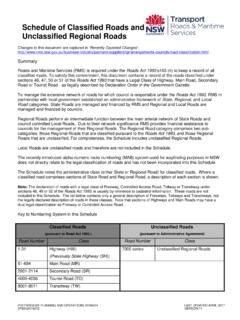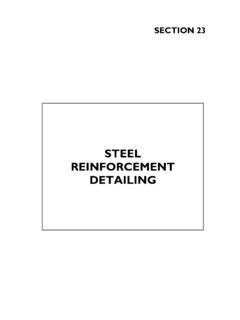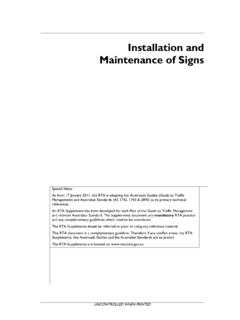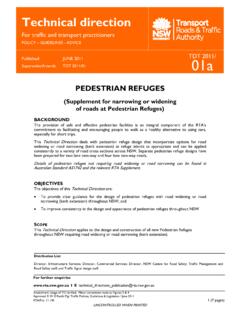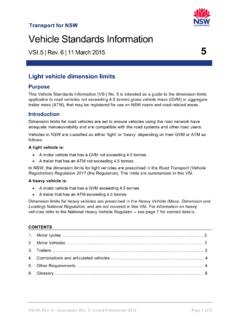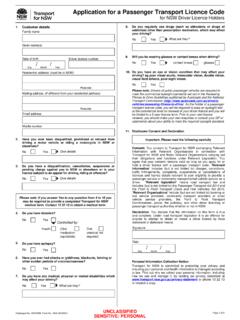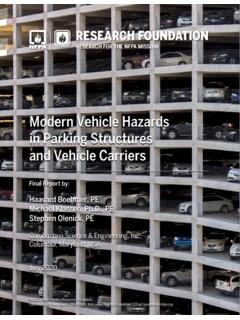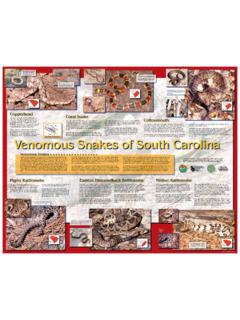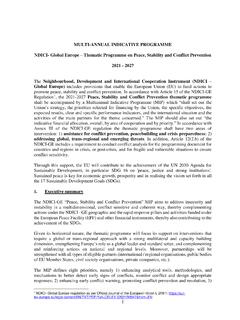Transcription of NSW Boat Ramp Facility Guidelines - Transport for NSW
1 September 2015 NSW boat ramp Facility Guidelines NSW boat ramp Facility Guidelines i DISCLAIMER The information in the Guidelines is intended only to provide general guidance on the design of boat ramp facilities for small recreational crafts. Whether these Guidelines are applicable and how they should be applied will depend on the specific Facility , including site specific environmental conditions, the anticipated level and type of boat ramp usage and the requirements of local authorities. These Guidelines (including any illustrations) should not be used for any type of final construction project drawings or specifications. You should obtain advice from engineers with appropriate expertise. These Guidelines are designed to be used alongside the relevant Australian standards. You should always refer to the most current version of the relevant standards and should not rely on these Guidelines in place of considering the relevant standards.
2 Compliance with these Guidelines does not mean that a Facility meets the applicable legal and regulatory requirements or will receive the necessary approvals. You should obtain independent advice on these matters. Roads and maritime developed these Guidelines by updating the NSW boat Launching Ramps Guidelines 1985 prepared by the NSW Public Works Department and in consultation with a number of stakeholder groups. While all reasonable care has been taken to ensure the accuracy of the materials in these Guidelines , Roads and maritime makes no representations or warranties of any kind about the accuracy, reliability, completeness or suitability or fitness for purpose in relation to these Guidelines . Roads and maritime does not accept and expressly disclaims any liability or responsibility for any loss, damage or costs howsoever incurred by any person as a result of or in connection with reliance upon any part of these Guidelines .
3 COPYRIGHT NOTICE Copyright Roads and maritime Services 2015 This document is subject to copyright. Apart from any use permitted under the Copyright Act 1968, no part may be reproduced by any process, nor may any other exclusive right be exercised, without the prior written permission of Roads and maritime Services. DOCUMENT CONTROL NSW boat ramp Facility Guidelines Revision Description Date issued Issued for web publishing on Roads and Maritimer Services webpage September 2015 NSW boat ramp Facility Guidelines ii CONTENTS Page FOREWORD IV 1 GENERAL 1 Objectives and Scope 1 Relevant Standards 1 Preliminary Planning Considerations 2 Overview of Approvals Process 3 2 BOATS AND TRAILERS 5 3 Facility SCALE 6 Regional and Local Facilities 6 Urban and Rural Facilities 6 4 Facility LOCATION AND EXPOSURE 9 General Considerations 9 River Flow 9 Wave Action 10 Wind Exposure 10 Other Alignment Considerations 10 Sedimentation 10 Open Coast Settings 11 5 boat ramp 12 Configuration 12 Number of Lanes 12 Lane Width 12 Toe Depth 13 ramp Slope 14 ramp Crest Level 14 ramp Length 15 boat ramp Surface Finish and Construction Methods 15 General 15 Above
4 Mean Water Level 16 Below Mean Water Level 16 Foundation Design 19 Structural Design 20 General 20 Design Life 20 Safety in Design 20 ramp Loading 21 Environmental Loading 21 Load Combinations 21 NSW boat ramp Facility Guidelines iii Materials 21 Reinforced Concrete Details 21 Inspections and Maintenance 23 6 ACCESSWAYS, MANOEUVRING AND PARKING AREAS 27 Car and Trailer Parking Numbers 27 Car and Trailer Parking Arrangements 28 Rigging, Manoeuvring Area and De-Rigging 31 Accessways 32 Surface Treatments and Water Management 33 Typical Layout and Dimensions 35 7 PONTOONS, JETTIES AND HOLDING BEACHES 37 General 37 Pontoons, Jetties and Gangways 37 General 37 Pontoons 37 Jetties 42 Gangways 44 Holding Beaches 45 8 ANCILLARY ramp AMENITIES 46 9 GLOSSARY 48 10 BIBLIOGRAPHY 53 APPENDIX A Drawings NSW boat ramp Facility Guidelines iv FOREWORD The original NSW boat Launching Ramps Guidelines were prepared by the NSW Public Works Department (PWD) in 1978 and a revised edition was later released in 1985.
5 This concise document has stood the test of time and it remains largely relevant. For the past 30 years it has been an industry guideline for the design and upgrade of boat ramps in NSW. The NSW Marina Guidelines were prepared by PWD in 1987 and were followed by Australian Standard AS 3962 Guidelines for Design of Marinas, finalised in 2001. Both documents incorporated boat ramps, with the Australian Standard drawing from, but superseding, the earlier NSW Marina Guidelines . There are some minor differences in the treatment of boat ramps in the 1985 Guidelines and AS 3962-2001. Various changes have emerged in recent decades with recreational boating activities in NSW. The capacity and power of tow vehicles is improving with technology such as traction control now common place and trailerable boats increasing in size and being fitted with more powerful engines. Both of these factors influence the loading on ramps and alter the design requirements of ramps and associated facilities.
6 Changes to boat ramp facilities and amenities have also occurred. Pontoons are now more common, particularly use of on- ramp pontoons, and a Facility which includes pontoon access attracts a higher level of usage. This document, which was prepared with the assistance of Royal Haskoning DHV, replaces the NSW boat Launching ramp Guidelines . It is a result of a review of the previous guideline with the objective to update and refresh its content to reflect modern day boating requirements. In addition, the new Guidelines aim to be consistent with relevant Australian Standards and modern day usage and expectations of boat ramp users. This Guideline has been prepared in consultation with key representatives from NSW Roads & maritime Services (RMS), The boat Owners Association of NSW, Recreational Fishing Alliance of NSW, NSW maritime Advisory Council, NSW Recreational Vessels Advisory Group, Marine Rescue, selected recreational fishing clubs and local Councils.
7 NSW boat ramp Facility Guidelines 1 1 GENERAL Objectives and Scope The objectives of these Guidelines , intended to be used alongside the relevant Australian Standards, are: to identify the main functional and design aspects that should be considered when planning the layout and components to be included within a new boat ramp Facility or incorporated in an upgrade to an existing boat ramp Facility ; and, to provide best practice technical and operational advice to assist with the design of the Facility . The content of this document is intended to provide guidance only. Application of these Guidelines would be subject to site specific environmental conditions, and should account for anticipated level and type of boat ramp usage and the requirements of local authorities. It is recommended that as part of the planning and design process advice is sought from engineers with specific expertise in the design of small craft facilities.
8 The design parameters provided in this document are drawn from a number of relevant standards that exist at the time of writing. These should be checked for currency by the engineer as part of the design process. Relevant Standards Relevant Australian Standards that are referenced within these Guidelines include: AS 1170 Structural design actions; AS 1379-2007 Specification and supply of concrete; AS 1428-2010 Design for access and mobility set; AS 1657-2013 Fixed platforms, walkways, stairways and ladders Design, construction and installation; AS 1742-2014 Manual of uniform control traffic devices set; AS 1743-2001 Road signs specifications; AS 1744:2014 Standard alphabets for road signs; AS :2014 Aggregates and rock for engineering purposes Concrete aggregates; AS :2004 Part 1: Off-street car parking; AS :2004 Part 6: Off-street parking for people with disabilities; AS 3600-2009 Concrete structures; AS 3962-2001 Guidelines for design of marinas; and, AS 4997-2005 Guidelines for design of maritime structures.
9 NSW boat ramp Facility Guidelines 2 Reference should also be made to Australian Standard supplements published by RMS including: RMS Australian Standard Supplements: Australian Standard AS1742 Manual of Uniform Traffic Control Devices Parts 1 15 (July 2013); and, RMS Australian Standard Supplements: Australian Standard AS1743 Road Sign Specifications (July 2013). Information on the use of fibre reinforced polymers within concrete has been obtained from relevant Canadian design codes and manuals: CAN/CSA-S806-12 Design and Construction of Building Components with Fibre-Reinforced Polymers; and, Reinforcing Concrete Structures with Fibre Reinforced Polymers, Design Manual (ISIS Canada, 2007). Guidance is also provided in Austroads publications for pavement design aspects and turning path templates for specific design vehicles, and RMS Engineering Standards and Guidelines for maritime Structures.
10 Reference should be made to the Safe Design of Structures, Code of Practice (Safe Work Australia, 2012) for safety in design requirements. Preliminary Planning Considerations There are a number of preliminary considerations that should be taken into account as part of the initial planning and design process for a boat ramp Facility . These include: agreement on the scale and type of the Facility with local authorities; identification of stakeholders for consultation, which may include the asset owner(s), local authorities, State Government agencies, waterway user groups and the general public; review of existing facilities in the area and their current level of usage; prediction of the level and nature ( commercial/recreational powered craft, PWCs, non-powered craft) of usage of the proposed boat ramp Facility in consultation with stakeholders, taking into consideration peak holiday periods and special events; identification of any particular usage requirements of emergency services, including Police, Water Police, Marine Rescue, State Emergency Service and Ambulance; review of vessel and boat licence registrations in the catchment area for the proposed boat ramp .

